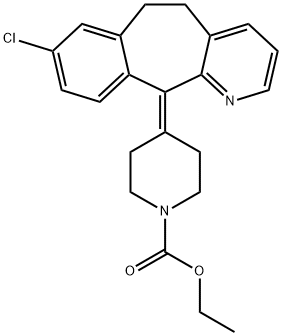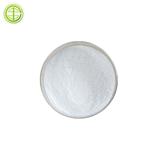Loratadine, sold under the brand name Claritin among others.Loratadine(Claritin) is a long-acting, non-sedating antihistamine that is used for the treatment of allergies. Histamine is a chemical that causes many of the signs and symptoms of an allergy. Histamine is released from histamine-storing cells (mast cells) and attaches to other cells that have receptors for histamine on their surfaces. Histamine stimulates the cells to release chemicals that produce effects that we associate with allergy, including welts, itching, and tissue swelling. Loratadine(Claritin) blocks one type of histamine receptor (the H1 receptor) and thus prevents activation of cells with H1 receptors by histamine.
Loratadine is a common antiallergic medication, which is a second generation long-acting tricyclic antihistamine, rapid onset of action is strong, does not contain hormones, absorbed by the body metabolism with more active desloratadine, inhibiting histamine H1 receptor by competitively inhibit histamine-induced allergic symptoms, with no obvious anticholinergic and central inhibition. It is used for the relief of clinical symptoms of allergic rhinitis related, such as sneezing, runny nose and nasal itching, eye itching and burning. It is also used to relieve symptoms of chronic urticaria and other allergic skin diseases.
Inhibition of hepatic drug-metabolizing enzyme function drugs can slow the metabolism of the product, such as itraconazole, ketoconazole, Daily with 400 mg ketoconazole suit, can make the product and its active metabolite to carboxyethyl loratadine increased plasma concentrations, but it was not observed in the changes of electrocardiogram (ECG). It can also inhibit the metabolism of loratadine when used with macrolides, cimetidine, theophylline and other drugs together.
- Antihistamines, peripheral nerves are highly selective H1-receptor, the role of strong, long time. For allergic arthritis, allergic rhinitis.
- National second-class anti-allergy drugs, for the relief of seasonal allergic rhinitis nasal and non-nasal symptoms and relieve chronic urticaria.
Common side effects include sleepiness, dry mouth, and headache. Serious side effects are rare and include allergic reactions, seizures, and liver problems. Use during pregnancy appears to be safe but has not been well studied. It is not recommended in children less than two years old. It is in the second-generation antihistamine family of medication.
Compound (I) (0.05mo1) was dissolved in toluene (450m1), dropwise addition of ethyl chloroformate (0.15mo1). Canada finished in the sauna heating 2h, and then stirred at room temperature overnight. Added 800ml water. The benzene layer was separated, washed with water, and dried. Decompression concentrated oil, with petroleum ether after impregnation with acetonitrile, recrystallization, the yield of loratadine, 64%.
https://en.wikipedia.org/wiki/Loratadine
http://www.medicinenet.com/loratadine/article.htm
Loratadine is a non-sedating antihistamine indicated for use in allergic rhinitis and chronic
urticaria. Its major advantage over other non-sedating antihistamines such as astemizole
and terfenadine is its very fast onset of action. Loratadine is claimed not to cross the
blood-brain barrier.
Histamine H1 receptor antagonist; antihistamine.
antinflammatory, analgesic, antipyretic
A nonsedating-type histamine H1-receptor
Loratadine, is used as a peripheral histamine H1 receptor agonist. It is also used as an orally active antiallergic agent. It is an important raw material and intermediate used in Organic Synthesis, Pharmaceuticals, Agrochemicals and Dyestuff.
Loratadine (Claritin) is a long-acting, potent peripheral H1 blocker with minimal
sedative effects. It does not appear to have the same adverse cardiac effects as
the other nonsedating H1 antihistamines. It is indicated for allergic rhinitis and
chronic urticaria.
ChEBI: Loratadine is a benzocycloheptapyridine that is 6,11-dihydro-5H-benzo[5,6]cyclohepta[1,2-b]pyridine substituted by a chloro group at position 8 and a 1-(ethoxycarbonyl)piperidin-4-ylidene group at position 11. It is a H1-receptor antagonist commonly employed in the treatment of allergic disorders. It has a role as a geroprotector, a H1-receptor antagonist, an anti-allergic agent and a cholinergic antagonist. It is an ethyl ester, a N-acylpiperidine, a tertiary carboxamide, an organochlorine compound and a benzocycloheptapyridine. It is functionally related to a desloratadine.
Preparation of Loratadine
In a two-liter vessel provided with a thermometer, a reflux condenser and nitrogen atmosphere, dry tetrahydrofuran (343 ml) was placed, and cooled between 0 and -5°C. Titanium tetrachloride (28.5 ml, 49.5 g, 0.255 mol) was slowly added with stirring (17 min.), keeping the temperature in the above indicated range, a yellow suspension being formed. After the addition was finished, stirring was continued for 10 min. Then, zinc dust (34.5 g, 0.524 mol) was added with stirring in approximately 15 min. keeping the temperature in the above cited range, and after addition was finished, stirring was continued at this temperature for 20 min., a blue suspension being formed. Then, pyridine (17 ml, 0.21 mol) was added with stirring, keeping the temperature in the above range, and then, a solution of 8-chloro-5,6- dihydrobenzo[5,6]cyclohepta[1,2-b]pyridin-11-one (30.0 g, 0.123 mol) and ethyl 4-oxopiperidine-1-carboxylate (25.2 g, 0.147 mol) in anhydrous tetrahydrofuran (96 ml) was added in about 20 min., with stirring and keeping the temperature in the above cited range. The, thus obtained, dark brown mixture was stirred for 3 h keeping the temperature in the above cited range, then was allowed to heat to room temperature and kept at this temperature for 2 h and then heated to 40°C for 17 h. The tetrahydrofuran was distilled off
from the reaction mixture to give a black resin that was dissolved in
dichloromethane (300 ml) and acidified by addition of isopropanol/HCl 7.2 N
(97 ml). The mixture was stirred for 10 min, and the phases were separated,
being the aqueous one extracted with dichloromethane (150 ml). The
combined organic phases were washed 6 times with a mixture of water (125
ml) and 35% aqueous HCl (7.5 ml). Then, the organic phase was basified to
pH 7.5-8.0 by addition of 30% aqueous NH3. The mixture was stirred for 10
min and the phases were separated, and then washed 3 times with water
(250 ml). The organic phase was dried with anhydrous sodium sulfate, filtered
and the solvent eliminated in vacuo to give a residue (47.47 g) that was
treated with acetonitrile (97 ml). The solid was filtered and crystallized from
the same solvent to give pure Loratadine, m.p. 132-133°C (18.8 g, 40%
yield).
Alavert (Wyeth); Claritin (Schering-Plough).
Antihistaminic, Antiallergic
Loratadine, 4-(8-chloro-5,6-dihydro-11Hbenzo[5,6]-cyclohepta[1,2-b]pyridin-l 1-ylidene-1-carboxylic acid ethyl ester, is a white to off-white powder insoluble in water but very soluble in acetone, alcohols, and chloroform. Loratadine is structurally related to the antihistamines azatadine and cyproheptadine, and to some tricyclic antidepressants. It differs from azatadine, in that a neutral carbamate group has replaced the basic tertiary amino moiety, and a phenyl ring has been substituted with a chlorine atom. Loratadine is a selective peripheral H1-antihistamine with a receptor-binding profile like that of the other members of this series, except that it has more antiserotonergic activity. Thus, it produces no substantial CNS or autonomic side effects or cardiac toxicity.
Loratadine displays potency comparable with that of astemizole and greater than that of terfenadine. Loratadine is indicated for the relief of nasal and nonnasal symptoms of seasonal allergic rhinitis. In the presence of a CYP3A4 inhibitor ketoconazole, loratadine is metabolized to descarboethoxyloratadine predominantly by CYP2D6.
Peripheral histamine H 1 receptor antagonist (K i = 35 nM); devoid of central effects. Orally active antiallergic agent.
Non-sedating histamine H1-receptor antagonist.
Good oral absorption, rapid and extensive metabolism in the liver, and excreted by urine and feces. After taking the medicine, the effect is fast, and some patients show the effect within 30 minutes. Tmax is 1.5 ~ 2 h, and the elimination half-life is 8 ~ 14 h. The half-life of the active metabolite decarboxymethylethoxyloratadine (DCL) is 17 ~ 24h. The half-life of the elderly and patients with liver disease may be longer. The binding rate of loratadine to plasma protein was 97% ~ 99%, and DCL was 73% ~ 76%. After 24 hours, about 27% of loratadine was excreted from urine, about 40% was eliminated from urine and 42% was excreted from stool after 10 days. With less milk secretion, it is safe to use drugs during lactation.
Loratadine is related to the first-generation tricyclic antihistamines and to
antidepressants. It is nonsedating, and neither it nor its major metabolite, desloratadine
(descarboethoxyloratadine), is associated with the potentially cardiotoxic effects reported for
terfenadine and astemizole. On chronic dosing, the AUC (plasma concentration–time curve)
for the metabolite is greater than that for the parent drug, and its half-life is longer.
Potentially hazardous interactions with other drugs
Antibacterials: concentration possibly increased by
erythromycin.
Antifungals: concentration of loratadine possibly
increased by ketoconazole – avoid concomitant use.
Antivirals: concentration possibly increased by
ritonavir.
Loratadine undergoes an extensive first pass metabolism, mainly by CYP3A4 and CYP2D6. The major metabolite-desloratadine is pharmacologically active and responsible for a large part of the clinical effect. Approximately 40% of the dose is excreted in the urine and 42% in the faeces over a 10 day period and mainly in the form of conjugated metabolites. Approximately 27% of the dose is eliminated in the urine during the first 24 hours. Less than 1% of the active substance is excreted unchanged in the active form, as loratadine or desloratadine.
10 mg daily. Patients with liver or renal impairment should be
started on a lower dose.



